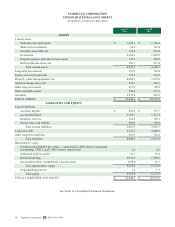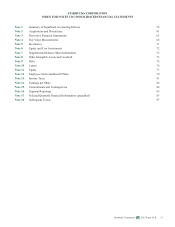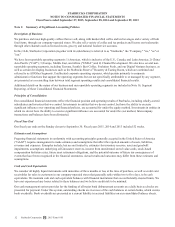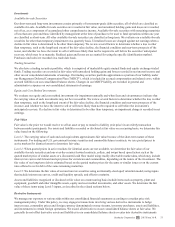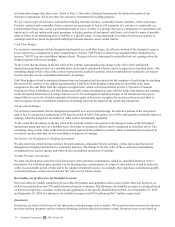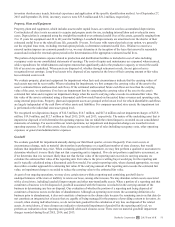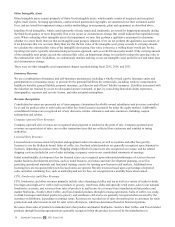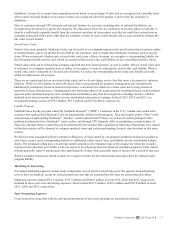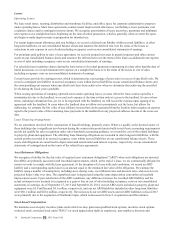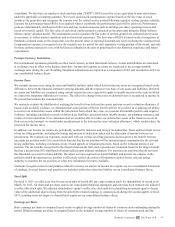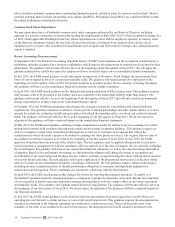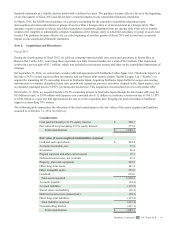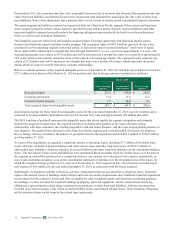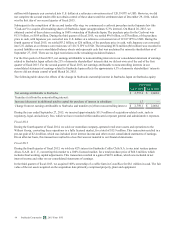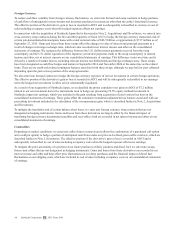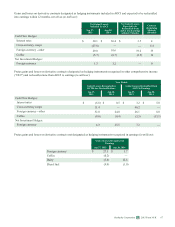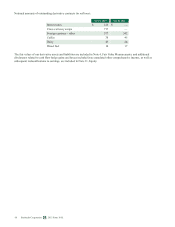Starbucks 2015 Annual Report Download - page 62
Download and view the complete annual report
Please find page 62 of the 2015 Starbucks annual report below. You can navigate through the pages in the report by either clicking on the pages listed below, or by using the keyword search tool below to find specific information within the annual report.
Leases
Operating Leases
We lease retail stores, roasting, distribution and warehouse facilities, and office space for corporate administrative purposes
under operating leases. Most lease agreements contain tenant improvement allowances, rent holidays, lease premiums, rent
escalation clauses and/or contingent rent provisions. We recognize amortization of lease incentives, premiums and minimum
rent expenses on a straight-line basis beginning on the date of initial possession, which is generally when we enter the space
and begin to make improvements in preparation for intended use.
For tenant improvement allowances and rent holidays, we record a deferred rent liability within accrued liabilities, or other
long-term liabilities, on our consolidated balance sheets and amortize the deferred rent over the terms of the leases as
reductions to rent expense in cost of sales including occupancy costs on our consolidated statements of earnings.
For premiums paid upfront to enter a lease agreement, we record a prepaid rent asset in prepaid expenses and other current
assets on our consolidated balance sheets and amortize the deferred rent over the terms of the leases as additional rent expense
in cost of sales including occupancy costs on our consolidated statements of earnings.
For scheduled rent escalation clauses during the lease terms or for rental payments commencing at a date other than the date of
initial possession, we record minimum rent expense on a straight-line basis over the terms of the leases in cost of sales
including occupancy costs on our consolidated statements of earnings.
Certain leases provide for contingent rent, which is determined as a percentage of gross sales in excess of specified levels. We
record a contingent rent liability in accrued occupancy costs within accrued liabilities on our consolidated balance sheets and
the corresponding rent expense when specified levels have been achieved or when we determine that achieving the specified
levels during the fiscal year is probable.
When ceasing operations of company-operated stores under operating leases, in cases where the lease contract specifies a
termination fee due to the landlord, we record such expense at the time written notice is given to the landlord. In cases where
terms, including termination fees, are yet to be negotiated with the landlord, we will record the expense upon signing of an
agreement with the landlord. In cases where the landlord does not allow us to prematurely exit the lease, but allows for
subleasing, we estimate the fair value of any sublease income that can be generated from the location and recognize an expense
equal to the present value of the remaining lease payments to the landlord less any projected sublease income at the cease-use
date.
Lease Financing Arrangements
We are sometimes involved in the construction of leased buildings, primarily stores. When we qualify as the deemed owner of
these buildings due to significant involvement during the construction period under build-to-suit lease accounting requirements
and do not qualify for sales recognition under sales-leaseback accounting guidance, we record the cost of the related buildings
in property, plant and equipment. The offsetting lease financing obligations are recorded in other long-term liabilities, with the
current portion recorded in in accrued occupancy costs within accrued liabilities on our consolidated balance sheets. These
assets and obligations are amortized in depreciation and amortization and interest expense, respectively, on our consolidated
statements of earnings based on the terms of the related lease agreements.
Asset Retirement Obligations
We recognize a liability for the fair value of required asset retirement obligations ("ARO") when such obligations are incurred.
Our AROs are primarily associated with leasehold improvements, which, at the end of a lease, we are contractually obligated to
remove in order to comply with the lease agreement. At the inception of a lease with such conditions, we record an ARO
liability and a corresponding capital asset in an amount equal to the estimated fair value of the obligation. We estimate the
liability using a number of assumptions, including store closing costs, cost inflation rates and discount rates, and accrete to its
projected future value over time. The capitalized asset is depreciated using the same depreciation convention as leasehold
improvement assets. Upon satisfaction of the ARO conditions, any difference between the recorded ARO liability and the
actual retirement costs incurred is recognized as a gain or loss in cost of sales including occupancy costs on our consolidated
statements of earnings. As of September 27, 2015 and September 28, 2014, our net ARO assets included in property, plant and
equipment were $5.8 million and $4.1 million, respectively, and our net ARO liabilities included in other long-term liabilities
were $60.1 million and $28.4 million, respectively. The increases in our net ARO assets and net ARO liabilities in fiscal 2015
were primarily due to the acquisition of Starbucks Japan, which is discussed in Note 2, Acquisitions and Divestitures.
Stock-based Compensation
We maintain several equity incentive plans under which we may grant non-qualified stock options, incentive stock options,
restricted stock, restricted stock units ("RSUs") or stock appreciation rights to employees, non-employee directors and
58 Starbucks Corporation 2015 Form 10-K


